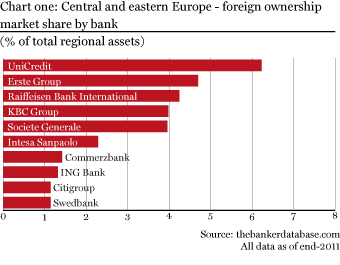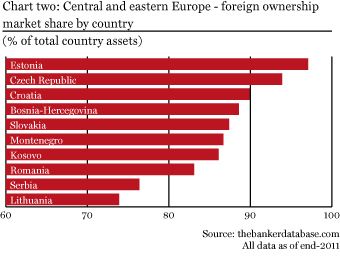Western European banks have a market share of almost two-thirds of assets in eastern Europe (excluding Russia), but their dominance does not extend to every market.
Banks headquartered in western Europe controlled more than 35% of assets in central and eastern Europe (CEE) at the end of 2011. Italy’s UniCredit leads the pack with a 6.23% market share across the region, while Austrian banks Raiffeisen Bank International and Erste Group both enjoy shares of more than 4%.
Among the top 10 foreign subsidiary networks in CEE, only one comes from beyond western Europe – US giant Citi, which has a 1.14% market share. Its Russian subsidiary accounts for one-third of its total assets in CEE, even though its market share there is a tiny 0.8%.
In fact, Russia is an outlier in the region, with the smallest proportion of foreign ownership. The dominance of large state-owned banks and a long tail of closely held banks means domestic players account for almost 90% of assets. If Russia is excluded from our sample, foreign ownership in CEE jumps to just fractionally less than 60%. Georgia also stands out, with a foreign ownership rate of just 13%, while less than 30% of banking assets in Belarus, Slovenia and Moldova are foreign owned.
At the other end of the scale, foreign banks – mainly Scandinavian – own 97% of Estonia’s banking assets, while the Czech Republic is also more than 90% in foreign hands.
However, ownership structures are set to change, as some western European players were badly hit by the financial crisis in 2008 and the subsequent eurozone sovereign crisis. KBC, the fourth largest player in our sample (and third largest excluding Russia), has merged its Polish subsidiary Kredyt Bank with Santander’s Bank Zachodni, retaining a stake of less than 17% in the combined entity. Without majority ownership of Kredyt Bank, KBC’s share of regional assets drops from almost 4% to 3.4%, pushing the bank down one place. Meanwhile, Santander’s regional share will rise from less than 0.9% to 1.4%, carrying it into the top 10.
Sberbank’s acquisition of Volksbank International (VBI) is rather less significant, as the combined network (excluding Romania, which Sberbank chose not to buy) has a regional market share of less than 0.5%. For now, Hungary’s OTP is likely to remain the largest CEE cross-border network for a bank headquartered in the region itself. OTP’s foreign subsidiaries have a 0.8% regional market share, dominated by Bulgarian subsidiary DSK’s hold on 11.6% of Bulgarian banking assets.




